Marrakech: is the fourth largest city in Morocco. It is one of the four imperial cities of Morocco and the capital of the Marrakesh–Safi region. It is west of the foothills of the Atlas Mountains. The region has been inhabited by Berber farmers since Neolithic times. The city was founded in 1070 by Emir Abu Bakr ibn Umar as the imperial capital of the Almoravid Empire. The Almoravids established the first major structures in the city and shaped its layout for centuries to come. The red walls of the city, built by Ali ibn Yusuf in 1122–1123, and various buildings constructed in red sandstone afterwards, have given the city the nickname of the “Red City” , “Ochre City” (ville ocre). Marrakesh grew rapidly and established itself as a cultural, religious, and trading center for the Maghreb. what are the most 10 visited attractions in Marrakech?

what are the most 10 visited attractions in Marrakech?
1-Jemaa el-Fnaa square:
The Jemaa el-Fnaa is one of the best-known squares in Africa and is the center of city activity and trade. It has been described as a “world-famous square”, “a metaphorical urban icon, a bridge between the past and the present, the place where (spectacularized) Moroccan tradition encounters modernity.” It has been part of the UNESCO World Heritage site since 1985. The square’s name has several possible meanings; the most plausible etymology endorsed by historians is that it meant “ruined mosque” or “mosque of annihilation”, referring to the construction of a mosque within the square in the late 16th century that was left unfinished and fell into ruin. The square was originally an open space for markets located on the east side of the Ksar el-Hajjar, the main fortress and palace of the Almoravid dynasty who founded Marrakesh. Following the takeover of the city by the Almohads, a new royal palace complex was founded to the south of the city (the Kasbah) and the old Almoravid palace was abandoned, but the market square remained. Subsequently, with the fluctuating fortunes of the city, Jemaa el-Fnaa saw periods of decline and renewal.

2-Souk(Market):
Marrakesh has the largest traditional market in Morocco and the image of the city is closely associated with its souks. Historically, the souks of Marrakesh were divided into retail areas for particular goods such as leather, carpets, metalwork and pottery. These divisions still roughly exist, though with significant overlap. Many of the souks sell items like carpets and rugs, traditional Muslim attire, leather bags, and lanterns. Haggling is still a very important part of trade in the souks.
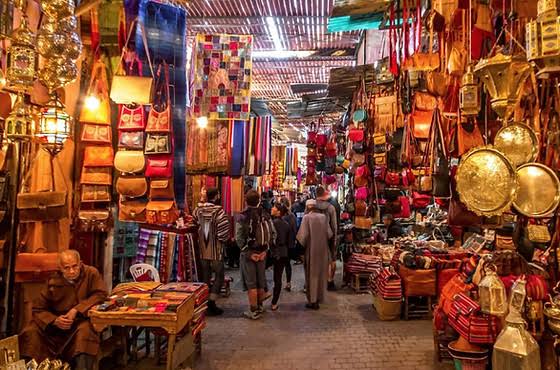
3-City walls and gates:
The ramparts of Marrakesh, which stretch for some 19 kilometres (12 mi) around the medina of the city, were built by the Almoravids in the 12th century as protective fortifications. The walls are made of a distinct orange-red clay and chalk, giving the city its nickname as the “red city”; they stand up to 19 feet (5.8 m) high and have 20 gates and 200 towers along them.

4-Gardens:
The city is home to a number of gardens, both historical and modern. The largest and oldest gardens in the city are the Menara gardens to the west and the Agdal Gardens to the south. The Menara Gardens were established in 1157 by the Almohad ruler Abd al-Mu’min. They are centered around a large water reservoir surrounded by orchards and olive groves. A 19th-century pavilion stands at the edge of the reservoir. The Agdal Gardens were established during the reign of Abu Ya’qub Yusuf (r. 1163–1184) and extend over a larger area today, containing several water basins and palace structures. The Agdal Gardens cover about 340 hectares (1.3 sq mi) and are surrounded by a circuit of pisé walls, while the Menara Gardens cover around 96 hectares (0.37 sq mi). The water reservoirs for both gardens were supplied with water through an old hydraulic system known as khettaras, which conveyed water from the foothills of the nearby Atlas Mountains

5-Majorelle Garden:
The Majorelle Garden, on Avenue Yacoub el Mansour, was at one time the home of the landscape painter Jacques Majorelle. Famed designer Yves Saint Laurent bought and restored the property, which features a stele erected in his memory, and the Museum of Islamic Art, which is housed in a dark blue building. The garden, open to the public since 1947, has a large collection of plants from five continents including cacti, palms and bamboo

Palaces and Riad: The historic wealth of the city is manifested in palaces, mansions and other lavish residences. The best-known palaces today are the El Badi Palace and the Bahia Palace, as well as the main Royal Palace which is still in use as one of the official residences of the King of Morocco. Riads (Moroccan mansions, historically designating a type of garden) are common in Marrakesh. Based on the design of the Roman villa, they are characterized by an open central garden courtyard surrounded by high walls. This construction provided the occupants with privacy and lowered the temperature within the building. Numerous riads and historic residences exist through the old city, with the oldest documented examples dating back to the Saadian period (16th-17th centuries), while many others date from the 19th and 20th centuries.
6-Bahia Palace:
Bahia Palace: is a magnificent palace and garden complex that showcases the opulence and grandeur of Moroccan architecture.
- History: The Bahia Palace was built in the late 19th century, between 1866 and 1867, by Grand Vizier Si Moussa. The name “Bahia” means “brilliance” or “beautiful” in Arabic, reflecting the splendor of the palace.
- Architecture: The palace is a masterpiece of Moroccan and Islamic architecture, featuring stunning courtyards, gardens, and intricately decorated rooms. It combines traditional Moroccan design elements with influences from various regions, including Andalusian and Moorish styles.
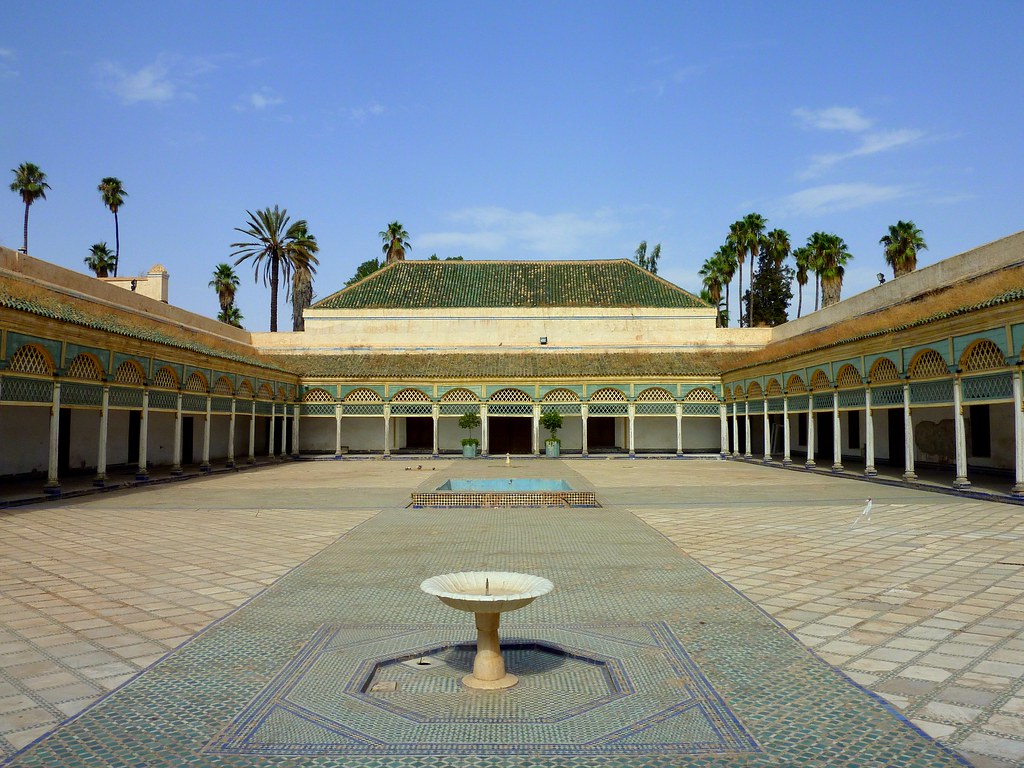
7-Royal Palace (Dar el-Makhzen):
The Royal Palace of Marrakesh, also known as Dar el-Makhzen, is located at the southern end of the city, occupying most of the eastern section of the present-day Kasbah quarter. The Almohads first built a palace complex on this site in the 12th century, as part of their newly-built kasbah, but it was completely remodeled by the Saadians in the 16th century and the Alaouites after the 17th century. Much of its current form has been dated to the 18th century under the reign of Mohammed Ben Abdallah. The Alaouite palace today consists of several grand gardens and courtyards surrounded by various chambers and pavilions. The palace’s main entrance today is to the south, approached via a series of mechouars (walled squares) and gates. One visitor in the mid-1980s described a reception room which was “filled with Grand Concourse-repro Victorian settees covered in white-and-gold brocade”. The palace is still in use by the King of Morocco and is not open to the public.
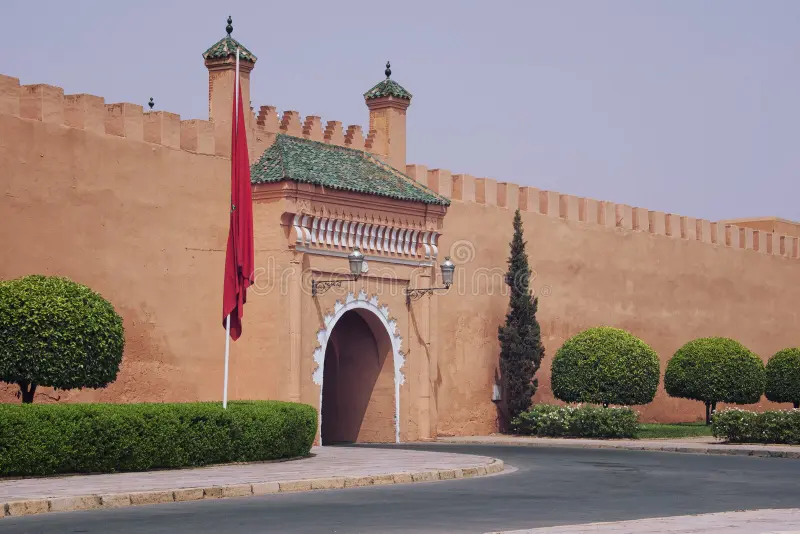
8-Koutoubia Mosque:
The Koutoubia Mosque is one of the largest and most famous mosques in the city, located southwest of Jemaa el-Fnaa. The mosque was founded in 1147 by the Almohad caliph Abd al-Mu’min. A second version of the mosque was entirely rebuilt by Abd al-Mu’min around 1158, with Ya’qub al-Mansur possibly finalizing construction of the minaret around 1195. This second mosque is the structure that stands today. It is considered a major example of Almohad architecture and of Moroccan mosque architecture generally. Its minaret tower, the tallest in the city at 77 metres (253 ft) in height, is considered an important landmark and symbol of Marrakesh. It likely influenced other buildings such as the Giralda of Seville and the Hassan Tower of Rabat.
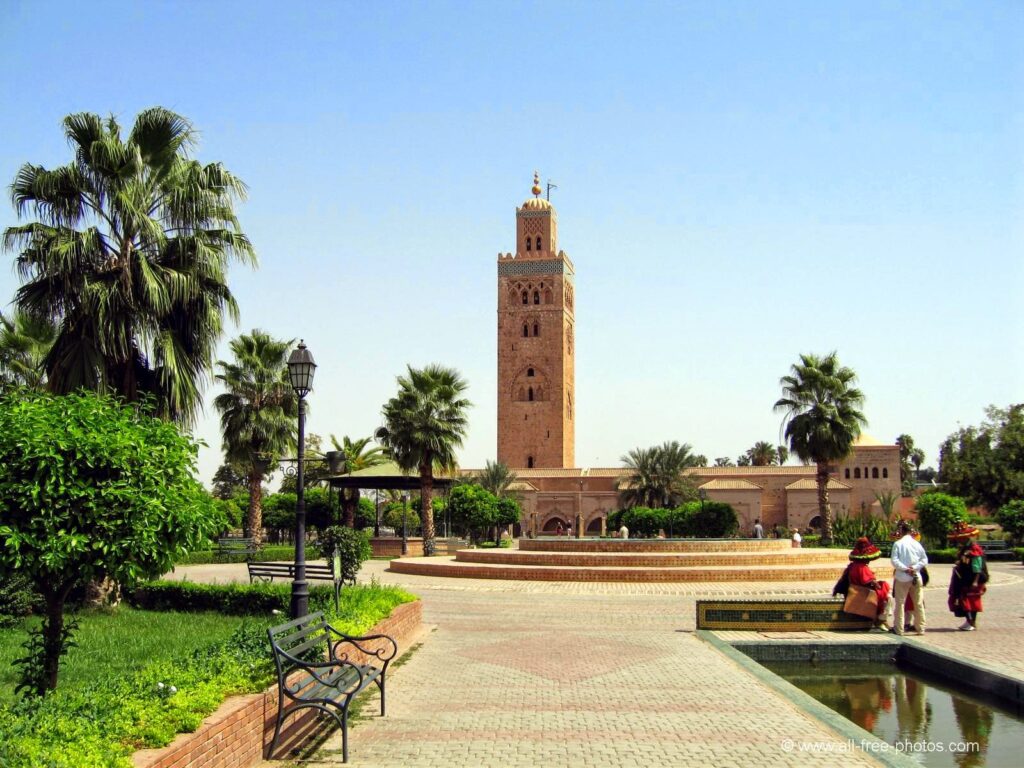
9-Saadian Tombs:
Saadian Tombs : is one of the most famous funerary monuments in the city , which were built in the 16th century as a royal necropolis for the Saadian Dynasty. It is located next to the south wall of the Kasbah Mosque. The necropolis contains the tombs of many Saadian rulers including Muhammad al-Shaykh, Abdallah al-Ghalib, and Ahmad al-Mansur, as well as various family members and later sultans. It consists of two main structures, each with several rooms, standing within a garden enclosure. The most important graves are marked by horizontal tombstones of finely carved marble, while others are merely covered in colorful zellij tiles. Al-Mansur’s mausoleum chamber is especially rich in decoration, with a roof of carved and painted cedar wood supported on twelve columns of carrara marble, and with walls decorated with geometric patterns in zellij tilework and vegetal motifs in carved stucco. The chamber next to it, originally a prayer room equipped with a mihrab, was later repurposed as a mausoleum for members of the Alaouite dynasty.
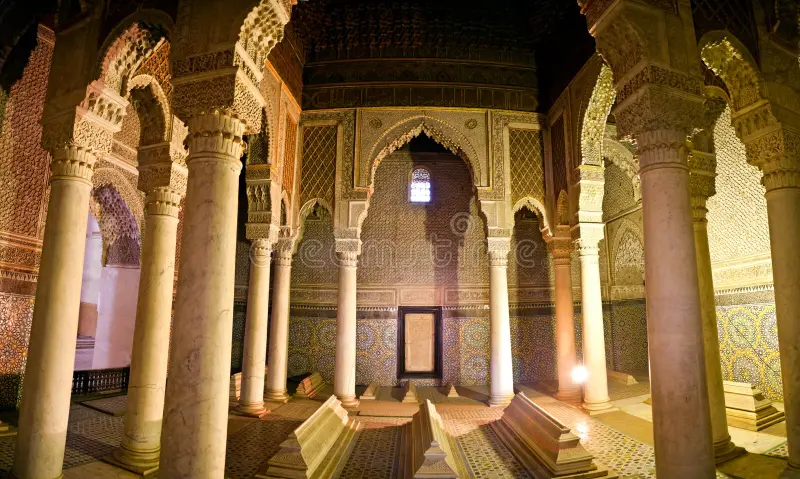
10-Ben Youssef Madrasa:
The Ben Youssef Madrasa, north of the Medina, was an Islamic college in Marrakesh named after the Almoravid sultan Ali ibn Yusuf (1106–1142) who expanded the city and its influence considerably. It is the largest madrasa in all of Morocco and was one of the largest theological colleges in North Africa, at one time housing as many as 900 students.

More informations:

